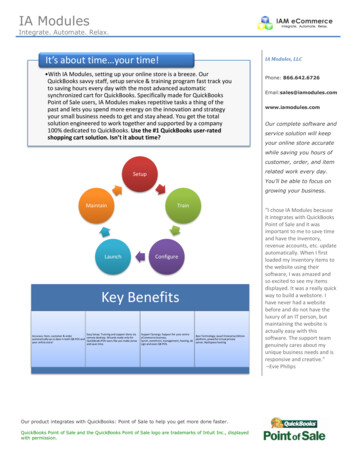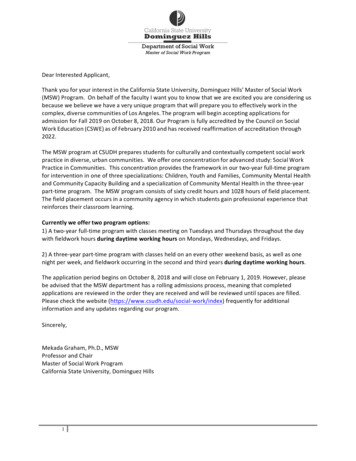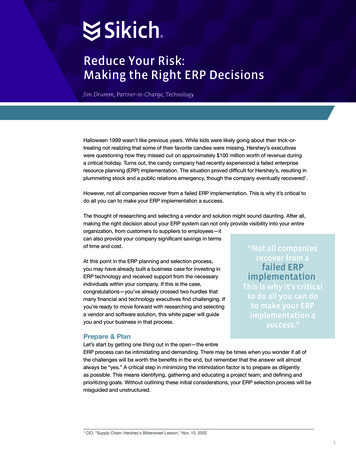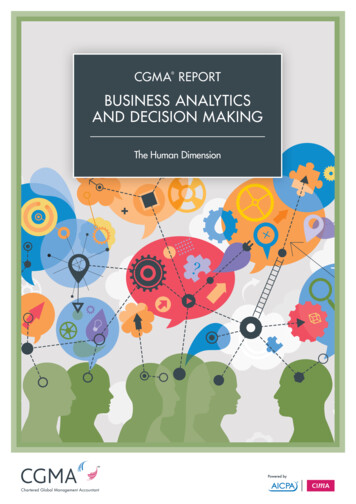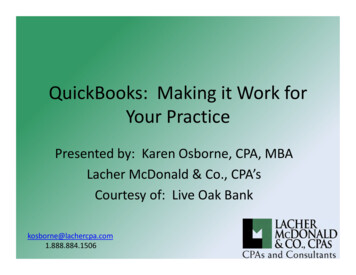
Transcription
QuickBooks: Making it Work forYour PracticePresented by: Karen Osborne, CPA, MBALacher McDonald & Co., CPA’sCourtesy of: Live Oak Bankkosborne@lachercpa.com1.888.884.1506
Why Should a Practice useQuickBooks? QuickBooks vs. Practice ManagementSoftware Importance of up-to-date financialinformation
How QuickBooks Should be Used Using the Accrual Basis of AccountingDefinition of Accrual Basis:The accrual basis means recognizing revenue whenit is earned (not only when the money is actuallyreceived) and recognizing expenses when they areincurred (not only when they are paid).
Why use the Accrual Basis? Matches Revenue to Expenses Accurate financial picture
Example: Accrual BasisMonthly Revenue: Practice ManagementReport:– Invoices 100,000– Clients paid 95,000– Accounts Receivableincreased by 5,000How much should Revenue bein QuickBooks under theAccrual Basis?
Example: Accrual BasisReference Lab Expense: January Reference Lab Bill:– Amount 4,000– Date of Invoice 1/31/13– Invoice Due 2/20/13How much should yourReference Lab Expense be inQuickBooks under the AccrualBasis for the month ofJanuary?
Set ALL Reports to Accrual Basis
Set ONE Report to Accrual Basis
How to Set up QuickBooks Goal: Meaningful Financial Statements Correctly use and set up your Chart ofAccounts– AAHA Chart of Accounts recommended
To Access the Chart of AccountsHome screenMenu access
Chart of Accounts Balance Sheet s receivable (A/R)Other current assetFixed assetOther assetAccounts payable (A/P)Credit cardCurrent liabilityLong-term liabilityEquity
Chart of Accounts Income and Expense Accounts:– Income– Cost of Goods Sold– Expense– Other Income– Other Expense
Revenue Accounts Classified by Sources of al FeesPharmacy SalesLaboratory FeesVaccination FeesBoarding FeesGrooming FeesDiagnostic Imaging FeesDental FeesFood Sales – Wellness & RxRetail SalesDiscounts
Revenue You will put your revenue into thesecategories on a MONTHLY basis not daily These categories will summarize the revenuecategories in your Practice ManagementSoftware
Revenue
Cost of Goods Sold Cost of Goods Sold Accounts– Medical Supplies– Prescriptions– Lab Expense– Food – Wellness & Rx– Retail– Other Cost of Goods Sold
Revenue & Cost of Goods Sold
Recording Payroll Recommended Payroll Accounts:– Officer Salaries– Salaries & Wages – Staff– Salaries & Wages – Associate Veterinarians Payroll should be recorded at GROSS amounts
Example Payroll Accounts
Example: Payroll Journal EntryGross pay for eachemployee typePayroll Tax expense(employer portionof payroll taxes)Matches amountsdeducted from bankby payroll company
Expense Accounts Appropriate level of detail Broad expense categories
Liabilities Two parts of a loan payment– Principal portion Balance Sheet item– Interest portion Profit & Loss item
Principal and InterestExample Loan StatementExample Amortization Schedule
Example: Check for Loan Payment
Banking Menu Make Deposits
Entering Daily Deposit
Deposits Your deposits should be deposited in the bankat the GROSS amount Almost all merchant service providers (withthe exception of Care Credit) will make yourdeposits at gross and deduct the fee at theend of each month
Enter Credit Card Charges
Practice Credit Card Charges Should be entering credit card charges Allows you to track your credit card balances– Extremely important if you carry a balance eachmonth
Account Reconciliation Should be reconciling both bank and creditcard accounts each month
Account Reconciliation
Vendors MenuEnter BillsPay Bills
Enter Bills/Pay Bills Allows you to record the expense in thecorrect period but pay in another period Helps you to match expenses to thecorresponding revenue
Reference Lab Example: Check January Reference LabBill:– Amount 4,000– Date of Invoice 1/31/13– Invoice Due 2/20/13Date the expense is recordedin the ‘Lab Expense’ account
Reference Lab Example: BillDate the expense is recordedin the ‘Lab Expense’ account
Cost of Goods Sold Entering invoices properly helps monitor thisexpense Invoices vs. Statements– You should be entering each individual invoice intoQuickBooks (Enter Bills function)– Using your monthly statement to check off eachindividual invoice (Pay Bills Function)
Enter Bills/Pay Bills What does entering the invoices accomplish:– Allows you to check the statements you receive– Makes sure the expenses are captured in thecorrect period Statement may span more than one month Statement may contain delayed billing
Example Bill Invoice Total 1,011.14 10 items received– 70% Prescriptions– 20% Medical Supplies– 10% Lab relatedEstimated amountsfrom invoice
When Not to Use Enter/Pay Bills When you are sitting down to pay anindividual or company immediately
Pay Bills – Hint #1When the bill is selected the Amt. To Payfield is auto-filled with the Amt. DueHighlight the Amt. To Pay to edit the fieldChange Amt. To Pay field to whateveramount you actually plan to pay
Pay Bills – Hint #2Choose Methodof Payment(Check or CreditCard)Choose corresponding Bankor Credit Card account
Practice Management SoftwareReports for entry into QuickBooks1. Accounts Receivable (AR) ReportA. Shows amount owed by clientsB. Want the report as of the last day of the month2. Inventory ReportA. Shows total cost of all inventory items in PracticeB. Want the report as of the last day of the month3. Sources of Revenue ReportA. List revenue generated by revenue categoryB. Want the report for a one month period (i.e.12/1/2012 to 12/31/2012)
Make General Journal Entries
Accounts Receivable Updating will help the income (revenue) inQuickBooks be accurate Decrease in Accounts Receivable frompayments received on prior months services Increase in Accounts Receivable for clients notpaying for current services
Accounts Receivable EntryStep #2New Accounts Receivable Total fromPractice Management ReportStep #1BeginningAccountsReceivableTotalStep #4Step #3Verify new Accounts Receivabletotal matches PracticeManagement ReportEnter Journal Entry to increaseAccounts Receivable Total
Inventory Adjusting your Inventory total in QuickBookseach month helps your Cost of Goods Soldtotal to be accurate Your Cost of Goods Sold is supposed torepresent the cost of materials used andproducts sold during the period
Inventory Entry Very similar to Accounts Receivable journalentry we went through– Different accounts will be debited and credited inthe journal entry You will want help with these entries the firsttime
Revenue Allows you to:– See very easily where your revenue is comingfrom– Easily compare to industry benchmarks and yourPractice– Compare it to your Cost of Goods Sold accounts
Revenue EntrySample Revenue ReportJournal EntryTotal LabCategories(blue)
Caution If you have not been tracking AccountsReceivable or Inventory in QuickBookspreviously you will want to get assistance fromyour CPA!
Useful Reports: Profit & Loss Standard Also known as anIncome Statement– Summarizes income andexpense accounts– Tells you if you areoperating at a profit or aloss
Useful Reports: Profit & Loss Prev YearComparison Summarizes incomeand expense accountsfor the chosen periodand previous period Can compareperformance againstsame period last year
Useful Reports: Balance SheetStandard Summarizes a Practicesfinancial position Shows the value of thePractice’s assets (whatit owns) and liabilities(what it owes)
Useful Reports: A/P Aging Summary Summarizes the status ofunpaid bills in AccountsPayable Shows:– What you owe– Who you owe it to– And how much is overdue
Other Useful Items: Find FeatureSimple tabAdvanced tab
Other Useful Items: Set up Users Allows users access toonly certain areas ofQuickBooks
Other Useful Items: Additional DetailMouse pointer turns intoa magnifying glassDrop-down Sortingoptions on top of report
Other Useful Items: Additional Detail(cont’d)Report Totaled by ‘Payee’PayeeTotal for specific Payee
QuickBooks: Making it Work forYour PracticePresented by: Karen Osborne, CPA, MBALacher McDonald & Co., CPA’sCourtesy of: Live Oak Bankkosborne@lachercpa.com1.888.884.1506
Accounts Receivable Entry. Beginning Accounts Receivable Total New Accounts Receivable Total from Practice Management Report Step #3 Step #2 Step #1 Enter Journal Entry to increase Accounts Receivable Total Verify new Accounts Receivable total matches Practice Management Report File Size: 1MBPage Count: 59




